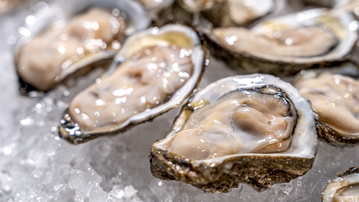Eat oysters safely
Eating raw oysters can carry a risk of food poisoning. Shellfish can contain harmful bacteria and viruses because of the way they feed.

Although oysters are traditionally eaten raw, people should be aware of the risks involved in eating them in this way. The Food Standards Agency advises that older people, pregnant women, very young children and people who are unwell should avoid eating raw or lightly cooked shellfish to reduce their risk of food poisoning.
Oysters filter large volumes of water to get their food. This means bacteria and viruses in the water can build up within the oyster.
Controls before and after commercial harvesting provide good protection against harmful bacteria. However, it can be difficult to remove viruses from live shellfish.
Thorough cooking destroys these viruses, but many people eat shellfish raw or partly cooked. So the shellfish may still contain viruses when eaten.
Buy good oysters
Buy your oysters from a reputable fishmonger, retailer or supplier
You can tell if an oyster is fresh, when you tap an open shell it should close
The oyster should also smell clean and briny
Store oysters safely
You should:
- always keep the oysters stored with the curved side downwards, this helps to keep the fluid in the shell and keep them alive
- store oysters away from other open foods in a deep bowl, this prevents leaks
- keep them between 4°C and 8°C but no colder, because they’re live animals and you don’t want to freeze them
- not put the oysters back into the water because the purification centre purifies them and you’d risk recontaminating them
By following this guidance, the oysters should last at least 5 days.
Handle oysters safely
You should:
- wash your hands before opening the oysters
- clean knives, gloves, other equipment, and your work area before you start opening the oysters
- check the oyster shells are clean
- avoid pushing mud or bits of shell into the oyster as you open it
- make sure the shell and meat are clean and white, a little pink or gray highlighting is acceptable, beneath a glassy sheen
- throw the oyster away if the meat or liquor looks cloudy, brown, gray, blackish or reddish, or if it smells unpleasant
- avoid eating oysters and drinking spirits at the same time
- serve oysters quickly
- tell someone if you plan to give them oysters because some people can have an allergic reaction
Page last updated: 01 May 2024
